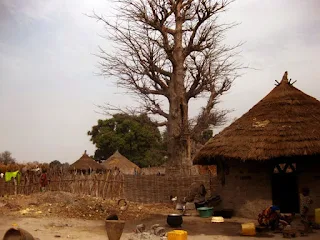In some countries like Gambia, they appear to be very common while other countries they are infrequent. Construction is from stout to tight to haphazard piled brush to sketchy.
I am not attempting to diminish the issues with large cats, but there seems to be little relationship between lion and leopard populations and the presence of boma.
I consulted with Peter (Thanks Peter!!!) over at Bayou Renaissance Man and he informed me that the fences are also intended to keep some domesticated animals in (like chickens) and others (like semi-feral dogs) out. Also a shout-out to commenter Arc who mentioned bomas.
He also said that they offer a layered defense against...whatever... There is often a wall around the village (which might be as small as four family groups) and then another that connects the hut, chicken house and grain-storage into a courtyard.
The Tribal nature of Africa
I don't pretend to be an anthropologist but even a casual reader of African history makes it clear that "tribal" is used in a couple of different ways.
The way it is used by the mainstream media is as a synonym for "language spoken by". So the Bantu tribe is the collection of all people who speak Bantu as their primary language.
At the boots-on-the-ground level, "tribe" means those you recognize by family ties. That is, at the village level. Tribal warfare means raids on, and skirmishes between villages. When available, the village will pick one that speaks a different dialect. But if the closest village speaks your dialect then they are equally likely to raid that one as walk an extra two km to raid a different language group's village.
A few more pictures
 |
| The short-wall around the well reduces the amount of fecal contamination at the start of the rainy season. |
 |
| You have to look closely to see the perimeter fence. |
 |
| The hut of the village leader |
 |
| I like how they wove finer brush into the bottom of this fence |
 |
| I like how they plugged the gap with loose brush |
I will add a couple of more later. I hear Quicksilver stirring.
 |
| Bookends. Top photo from Kenya in East Africa and bottom photo from Ghana in West Africa |









The way things are going we will probably be doing that here too in a few years. ---ken
ReplyDeleteThose bomas remind me of the stump fences that the pioneers built.
ReplyDeleteWattle fences have been in use atound the world for thousands of years and in every tiaga except polar regions.
ReplyDeleteIn countries of the Commonwealth, there are commercial firms which actually plan, design, install, and maintain such fences. Of course there are the individuals who hand the craft down from one generation to the next.
As shown in the photographs, the fences are efficient and make use of the scantest building material.
You can also tell whether they are 'permanent' or 'temporary' by how well built and maintained the fences are. Many African tribes move with the water/grass.
ReplyDeletethose ghanaians make a beautiful fence
ReplyDeleteThink English/Normandy hedges or for those of us familiar with life around the 100° meridian..."bo-darc" (Osage orange) hedges
ReplyDeleteI quit my office job and now I am getting paid 90 Dollars hourly. How? I work over the internet! My old work was making me miserable, e3 so I was forced to try-something different. 2 years later...I can say my life is changed completely for the better!
ReplyDeleteCheck it out what i do Click This Link.. AmericanWorthIncome